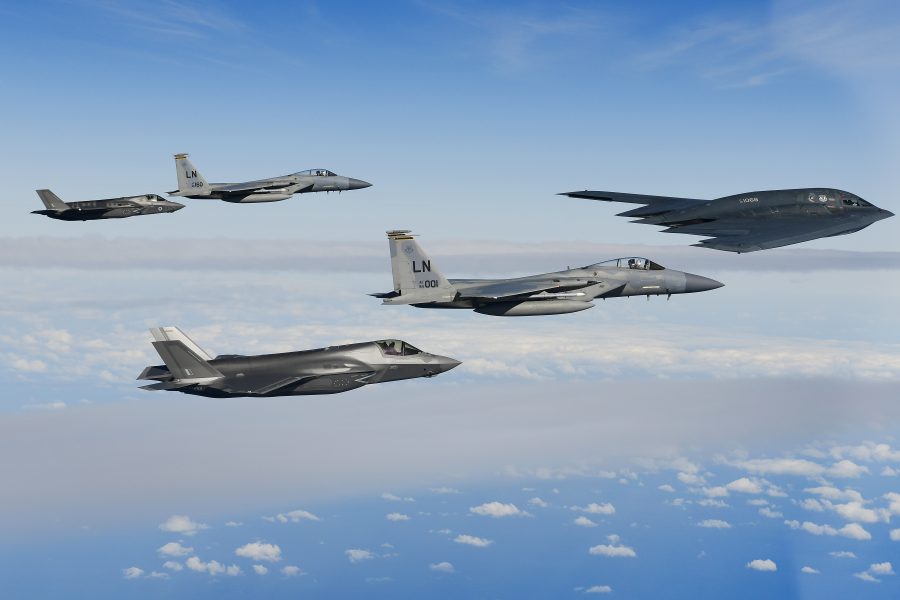The Air Force isn’t well structured to carry out the National Defense Strategy, and in order to deter a major war, it must add more and stealthier aircraft, expand its use of unmanned systems, accelerate the development of new technology, and learn to operate from more dispersed locations, according to a new report from the Center for Strategic and Budgetary Assessments.
The Air Force currently is sized to fight one war at a time, according to the study, “Five Priorities for the Air Force’s Future Combat Air Force,” which was released Jan. 22. This situation could potentially embolden an enemy to capitalize on USAF’s full commitment to a conflict in one theater by choosing that moment to act in another, thus damaging deterrence, the authors contend.
The 75-page report, written by Mark Gunzinger, Carl Rehberg, and Lukas Autenreid, builds on a previous CSBA study evaluating USAF’s “The Force We Need” construct by offering recommendations on how USAF should invest and shape itself to carry out the NDS.
“The Air Force has been living off major CAF [Combat Air Forces] weapon systems that were, in many cases, designed and delivered during the Cold War,” but are not optimum for the new, multi-polar political world, the authors assert.
They offered five recommendations that could “close the gap” between what USAF has and what the 2018 NDS demands of it.
First, CAF should be “sized for great power conflict.” Preventing Russia or China from succeeding with major acts of aggression “should be a fundamental force design priority,” the CSBA said. Sizing and shaping USAF to be able to deal with a second war would “reduce the risk” that an aggressor would take advantage of the US being all-in on one conflict.
“A two-war CAF should also have greater capacity to strike large target sets over long ranges and deep into contested areas,” a finding consistent with “the Force We Need,” both of CSBA’s previous reports, and one from the Mitre Corp. More bombers, for example, would “help deny operational sanctuaries to China, Russia, and other aggressors.”
Second, stealth aircraft are “a requirement” to operate in highly contested areas, and the Air Force doesn’t have enough, the CSBA report argued. It suggests USAF “accelerate” its purchase of F-35s, B-21s, and new types such as a Penetrating Counterair/Penetrating Electronic Attack (PCA/PEA) airplane, and penetrating unmanned intelligence, surveillance and reconnaissance systems.
The authors also urged the Air Force to go ahead with the B-2 bomber Defensive Management System upgrade and retain that airplane, rather than retire it in the early 2030s as is now planned. At the least, the B-2 should be kept in service until “significant numbers of B-21 bombers become operational” and as a hedge against a slip in the B-21 program. The authors urged USAF to keep improving the survivability of the F-22 and procuring next-generation weapons, including a family of hypersonic weapons, that could significantly increase USAF’s lethality.
Third, USAF needs to expand its ability to operate at greater distances from home base, and greater distances from the target area, the authors said. That means longer-range aircraft, as well as the ability to disperse the CAF among many locations to complicate the enemy’s ability to hit the Air Force on the ground.
To deny Russia or China “a fait accompli” by achieving their ends before USAF can get in the fight, the service “should be able to generate strike sorties from bases located in areas that are at less risk of high-density missile attacks and generate counterair and other combat sorties from dispersed networks of closer-in theater air bases.”
The authors added that these are “not ‘either-or’ options.” Both approaches will be needed to help the force survive and operate, and an enabling capability will be “higher capacity air base defenses against large-scale air and missile attacks.” While the authors said USAF should get more people to do air base protection, the Pentagon recently designated the Army as Executive Agent for short-range air defense.
Fourth, the authors said USAF should widely expand the number and type of missions that are conducted by remotely piloted aircraft or autonomous aircraft. Noting trends and plans that suggest the Air Force of 2030 will be scarcely—if at all—larger than the force of 2020, the report suggests turning to RPAs to “reduce the risk of shortfall” in capacity and capability. The mix should include more MQ-9A Reapers, which are already flying, “lower-cost, attritable” unmanned systems and uninhabited aircraft that can team with manned aircraft for missions including “counterair, long-range standoff area surveillance, strikes, electronic warfare, and other combat operations,” as well as ISR and light strike.
Finally, the CSBA report urged the Air Force to speed up the next generation of weapons, particularly “force multipliers.” Among these it counted hypersonic weapons; cruise missiles with high power microwave or counter-electronics payloads able to attack many targets with a single weapon; improved, fuel-sipping engines that will extend the range or mission endurance of aircraft; and new datalinks to support multi-domain operations in contested areas.
Moreover, replacing big-wing ISR systems like the E-3 AWACS and E-8 JSTARS with all-domain battle management command and control architectures would “increase the effectiveness and resiliency of the entire joint force in future operations.”
